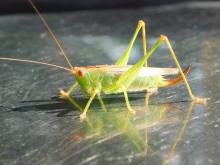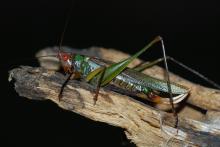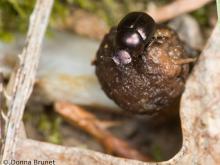Land Invertebrates
Media
Species Types
Scientific Name
About 11 species in North America north of Mexico
Description
Mantidflies look like a cross between a lacewing insect and a praying mantis. They are small, delicate creatures with intricately veined wings, but the front half looks like a mantid, complete with raptorial forelegs.
Media

Species Types
Scientific Name
Cicindela limbalis
Description
The common claybank tiger beetle, or green-margined tiger beetle, occurs on dirt clay soils in open areas in spring and, less abundantly, in late summer. Color varies from red to purple to green. The outer shell edges are often edged with shiny green.
Media

Species Types
Scientific Name
About 250 species in North America north of Mexico
Description
Katydids are a family of insects that may also be called longhorned grasshoppers, because of their super-long antennae. Many resemble green leaves. Others are brown. Members of some species may be bright pink or yellow.
Media

Species Types
Scientific Name
Orchelimum vulgare
Description
The common meadow katydid is aptly named: it is well-known and widespread in the eastern United States. Listen for its distinctive call — like a pulsating circular lawn sprinkler ratcheting around — in midsummer to the first hard frost.
Media

Species Types
Scientific Name
Orchelimum nigripes
Description
The black-legged meadow katydid is a gorgeous, strikingly marked katydid that hides among foliage. They are secretive and quick to hop away or move to the other side of a plant stem.
Media

Species Types
Scientific Name
Canthon spp.
Description
Tumblebugs in genus Canthon are usually seen on, near, and beneath poop. They are sometimes seen rolling dung balls away from the original heap, heads down and pushing the ball backward with their hind legs.
Media

Species Types
Scientific Name
About 1,700 species in North America north of Mexico
Description
The scarab beetle family is very large, with breathtaking variety — and often great beauty. Many scarabs are large and colorful.
Media

Species Types
Scientific Name
Subfamilies Scarabaeinae and Aphodiinae
Description
Horses, cattle, dogs, and deer all drop manna from above to eager dung beetles, which collect, hoard, and guard the precious organic materials left undigested in the pile.
See Also



Media

Species Types
Scientific Name
Cisseps fulvicollis
Description
The yellow-collared scape moth is more often “orange-collared.” And whether you think it looks more like a firefly or a wasp, it’s still a moth!
Media

Species Types
Scientific Name
Nearly 150 species in North America north of Mexico
Description
Slim, delicate plume moths are instantly recognizable by their T-shaped silhouette, long legs, and muted shades of tan and brown. It can be hard to separate the various species.
Media

Species Types
Scientific Name
Pyrrharctia isabella
Description
Not many people know the adult Isabella tiger moth when they see one, but we’re all acquainted with its caterpillar, the woolly worm, or woolly bear.
About Land Invertebrates in Missouri
Invertebrates are animals without backbones, including earthworms, slugs, snails, and arthropods. Arthropods—invertebrates with “jointed legs” — are a group of invertebrates that includes crayfish, shrimp, millipedes, centipedes, mites, spiders, and insects. There may be as many as 10 million species of insects alive on earth today, and they probably constitute more than 90 percent all animal species.





















